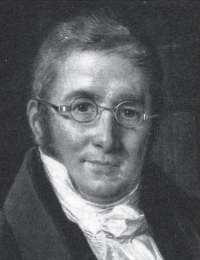Augustin Pyramis De Candolle (1778 - 1841) - a brief biography
The information below is derived from many sources; major reference texts are listed at the foot of the page.
Augustin Pyramus de Candolle was born on 4th February 1778 in Geneva, Switzerland, to a family which had originated in Provence, France but had left there nearly 200 years earlier to live in Switzerland and so escape religious persecution. As a child De Candolle enjoyed school and did well there, going on to undertake medical studies at Collège Calvin (formerly Collège de Genève, which was founded by John Calvin) under the tutorship of Jean Pierre Étienne Vaucher, who encouraged Augustin to focus his attention mainly on botany.
De Candolle first job was in a herbarium in Paris. There he documented many hundreds of plants while also working on new system for - Classifying plant families.
In 1807 Augustin was made professor of botany in the medical faculty at the University of Montpellier, and three years later he became the first chair of botany there. He returned to Geneva in 1816 and a year later took on the chair of natural history at the university there.
It is important to quote in full the name Augustin Pyramus De Candolle, because four generations of his descendants also became prominent figures in botanical work, including his son Alphonse De Candolle, who eventually held his father's former position as professor of botany at the University of Montpellier. Alphonse continued his father's work including adding to Prodromus Systematis Naturalis Regni Vegetabilis, a monumental collaborative attempt to describe every plant on earth. During his lifetime Augustin saw seven volumes through to completion, and in these the characteristics of more than 100 plant families were documented - about two thirds of the target Augustin De Candolle had set for this initiative. The word 'taxonomy' was one of his many legacies to the systematics of botany/mycology.
The plant genera the genera Candollea and Candolleodendron are named in honour of Augustin Pyramis De Candolle.
The mushroom Pale Brittlestem, Psathyrella candolleana, is named in honour of De Candolle.
After being seriously ill for several years, Augustin Pyramus de Candolle died in Geneva on 9th September 1841.
The abbreviation DC. is used to indicate Augustin Pyramus de Candolle as the author when citing a botanical or mycological name.
Positions and Awards
Founder of the Museum of Natural History, Geneva, Switzerland. (Its Conservatoire Botanique, also set up by Augustin De Candolle, now contains the world's largest herbarium.)
Major Mycological Works
Plantarum historia succulentarum - Histoire des plantes grasses; avec leurs figures en couleurs, dessinées par P.J. Redouté. (Issued in twenty sections between 1799 and 1802, with eight more sections added in 1803; as a result, one authority has declared that it is very difficult to determine what constitutes a complete copy of this work.)
Prodromus Systemis Naturalis Regni Vegetabilis (Systematic Guide to the Vegetable Kingdom of Nature) Includes not only - Classification and description, but also ecology, phytogeography, and phylogeny.
Théorie Elémentaire de la botanique, 1813.
Mémoires sur la Famille Legumineuse (Notes on the family of Legumes), 1825 - 1827.
Cours de Botanique, 1827.
Mémoires et Souvenirs (Memories and Recollections), 1862.
Selected Sources:
Scientific Papers of Asa Gray; Dr Asa Gray, 1889.
Biographies des Botanistes a Genève. Berichte der Schweizerischen Botanischen Gesellschaft.. v. 50a:114-130; John Briquet, 1940.
Augustin-Pyramus De Candolle, in Dictionary of Scientific Biography. v. III: 43-45; P. E. Pilet, 1971.
Four Generations of Memorable Botanists, in The Scientific Monthly 19 (1) July 1924; William Trelease.
Mémoires et Souvenirs (Memories and Recollections), Augustin Pyramis De Candolle, 1862.
Fascinated by Fungi, 2nd Edition, Pat O'Reilly 2016, reprinted by Coch-y-bonddu Books in 2022.
Fascinated by Fungi. Back by popular demand, Pat O'Reilly's best-selling 450-page hardback book is available now. The latest second edition was republished with a sparkling new cover design in September 2022 by Coch-y-Bonddu Books. Full details and copies are available from the publisher's online bookshop...

